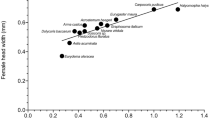Abstract
Two species of lace bugs,Dictyla echii (Schrank) andDictyla nassata (Puton), were tested for host specificity as potential biological control agents for Paterson's curse,Echium plantagineum L. A range of test plants from the family Boraginacea, from related families in the order Laminales and from species of economic importance in Australia which have had inadequate exposure in their countries of origin, were tested under both choice and non-choice conditions.
These bugs proved to be oligophagous within the Boraginaceae and attacked a number of Australian native species. Because of this,D. echii andD. nassata are not considered sufficiently specific to release from quarantine and tests were abandoned before completion of the test plant list.
Résumé
La spécificité parasitaire deDictyla echii (Schrank) etD. nassata (Puton) a été étudiée en tant qu'agents de lutte biologique potentiels contreEchium plantagineum L. Dans les conditions de choix et d'absence de choix, une série de plantes ont été testées provenant de la famille des Boraginacées, des familles voisines de l'ordre des Laminales et d'espèces d'importance économique en Australie qui n'avaient pas fait l'objet de tests suffisants dans leur pays d'origine.
Ces punaises se révèlent oligophages en ce qui concerne les Boraginacées et s'attaquent à de nombreuses espèces indigènes d'Australie. Pour cette raison,D. echii etD. nassata ne sont pas considérées comme suffisamment spécifiques pour les relâcher à partir de la quarantaine et les tests ont été abandonnés avant d'épuiser la totalité des plantes prévues sur la liste.
Similar content being viewed by others
References
Drake, C. J. &Ruhoff, F. A. — 1965. Lace bugs of the world: a catalogue (Hemiptera: Tingidae). —US Natl. Mus. Bull. 243, pp. 634.
Khaidarova, Z. M. — 1975. Insects that feed on the weedTrichodesma incanum (Bge) DC in Uzbekistan. —Entomol. Rev. Wash., 54, 50–54. (Translation ofEntomol. Oboze., 54, 780–786).
Putchkov, V. G. — 1974. Berytidae, Pyrrhocoridae, Piesmatidae, Aradidae and Tingidae. —Fauna Ukraini, 21, 1–332.
Vayssieres, J. F. — 1983. Life histories and Host specificities of theEchium bugsDictyla echii andDictyla nassata [Hem.: Tingidae]. —Entomophaga, 28, 135–144.
Wapshere, A. J. — 1974. A strategy for evaluating the safety of organisms for biological weed control. —Ann. Appl. Biol., 77, 201–211.
Wapshere, A. J. — 1981. The biological control of Paterson's curse,Echium plantagineum: Northern Hemisphere studies. — Proc. V Int. symp. Biol. Contr. Weeds, Brisbane, Australia, 1980, pp. 599–602.
Wapshere, A. J. — 1985. The phytophagous guild onEchium in the western Mediteranean and the biological control of the weed,Echium plantagineum. —Acta Oecol., 6, 331–338.
Wheeler, A. G. &Hoebeke, R. — 1985.Dictyla echii: seasonal history and North American records of an immigrant Lace Bug (Hemiptera: Tingidae). —J. New York Entomol. Soc., 93, 1057–1063.
Bodkin, F. — 1986. Encyclopaedia Botanica. The essential reference guide to native and exotic plants in Australia. —Angus & Robertson, North Ryde.
Cronquist, A. — 1981. An integrated system of classification of flowering plants. —Columbia University Press, New York.
Delfosse, E. S. — 1985. CSIRO Division of Entomology Submission to the Inquiries into Biological Control ofEchium plantagineum L. CSIRO, Canberra.
Drake, C. J. &Ruhoff, F. A. — 1965. Lacebugs of the World: a catalogue (Hemiptera: Tingidae). —US Natl. Mus. Bull., 243, pp. 634.
Heywood, V. H. — 1978. Flowering Plants of the World. —Oxford University Press, Oxford.
Jessop, J. P. &Toelken, H. R. — 1986. Flora of South Australia. Pt. III Polemoniaceae-Compositae. —South Australian Government Printing Div., Adelaide.
Parsons, W. T. &Cuthbertson, E. G. — 1992. Noxious Weeds of Australia. —Inkata, Melbourne.
Ross, J. H. (ed). — 1993. A census of the vascular plants of Victoria. —Royal Botanic Gardens, Melbourne.
Staff of Liberty Hyde Baily Hortorium. — 1978. Hortus Third. A Concise Dictionary of Plants Cultivated in the United States and Canada. —Macmillan Publishing Co., New York.
Tamas V. — 1978. Polish HeteropteraV. Fauna Hung. 132.
Vayssieres, J. F. — 1983. Life histories and host specificities of theEchium bugs,Dictyla nassata [Hem.: Tingidae].Entomophaga, 28 135–144.
Wheeler, A. G. &Hoebeke, E. R. — 1985.Dictyla echii: seasonal history and North American records of an immigrant lace bug (Hemiptera: Tingidae).J. New York Entomol. Soc. 93, 1057–1063.
Author information
Authors and Affiliations
Rights and permissions
About this article
Cite this article
Shepherd, R.C.H. Host specificity of the two lace bugs,Dictyla echii andDictyla nassata [Hem.: Tingidae] potential biological control agents for paterson's curse (Echium plantagineum). Entomophaga 40, 131–143 (1995). https://doi.org/10.1007/BF02373062
Received:
Accepted:
Issue Date:
DOI: https://doi.org/10.1007/BF02373062




